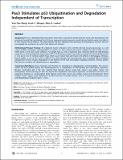| dc.contributor.author | Wang, Xiaodan | |
| dc.contributor.author | Morgan, Sarah C. | |
| dc.contributor.author | Loeken, Mary Rose | |
| dc.date.accessioned | 2013-02-14T21:34:15Z | |
| dc.date.issued | 2011 | |
| dc.identifier.citation | Wang, Xiao Dan, Sarah C. Morgan, and Mary R. Loeken. 2011. Pax3 stimulates p53 ubiquitination and degradation independent of transcription. PLoS ONE 6(12): e29379. | en_US |
| dc.identifier.issn | 1932-6203 | en_US |
| dc.identifier.uri | http://nrs.harvard.edu/urn-3:HUL.InstRepos:10303286 | |
| dc.description.abstract | Background: Pax3 is a developmental transcription factor that is required for neural tube and neural crest development. We previously showed that inactivating the p53 tumor suppressor protein prevents neural tube and cardiac neural crest defects in Pax3-mutant mouse embryos. This demonstrates that Pax3 regulates these processes by blocking p53 function. Here we investigated the mechanism by which Pax3 blocks p53 function. Methodology/Principal Findings We employed murine embryonic stem cell (ESC)-derived neuronal precursors as a cell culture model of embryonic neuroepithelium or neural crest. Pax3 reduced p53 protein stability, but had no effect on p53 mRNA levels or the rate of p53 synthesis. Full length Pax3 as well as fragments that contained either the DNA-binding paired box or the homeodomain, expressed as GST or FLAG fusion proteins, physically associated with p53 and Mdm2 both in vitro and in vivo. In contrast, Splotch Pax3, which causes neural tube and neural crest defects in homozygous embryos, bound weakly, or not at all, to p53 or Mdm2. The paired domain and homeodomain each stimulated Mdm2-mediated ubiquitination of p53 and p53 degradation in the absence of the Pax3 transcription regulatory domains, whereas Splotch Pax3 did not stimulate p53 ubiquitination or degradation. Conclusions/Significance: Pax3 inactivates p53 function by stimulating its ubiquitination and degradation. This process utilizes the Pax3 paired domain and homeodomain but is independent of DNA-binding and transcription regulation. Because inactivating p53 is the only required Pax3 function during neural tube closure and cardiac neural crest development, and inactivating p53 does not require Pax3-dependent transcription regulation, this indicates that Pax3 is not required to function as a transcription factor during neural tube closure and cardiac neural crest development. These findings further suggest novel explanations for PAX3 functions in human diseases, such as in neural crest-derived cancers and Waardenburg syndrome types 1 and 3. | en_US |
| dc.language.iso | en_US | en_US |
| dc.publisher | Public Library of Science | en_US |
| dc.relation.isversionof | doi:10.1371/journal.pone.0029379 | en_US |
| dc.relation.hasversion | http://www.ncbi.nlm.nih.gov/pmc/articles/PMC3247257/pdf/ | en_US |
| dash.license | LAA | |
| dc.subject | DNA-binding proteins | en_US |
| dc.subject | biology | en_US |
| dc.subject | biochemistry | en_US |
| dc.subject | proteins | en_US |
| dc.subject | developmental biology | en_US |
| dc.subject | morphogenesis | en_US |
| dc.subject | birth defects | en_US |
| dc.subject | stem cells | en_US |
| dc.subject | embryonic stem cells | en_US |
| dc.subject | embryology | en_US |
| dc.subject | organism development | en_US |
| dc.subject | model organisms | en_US |
| dc.subject | animal models | en_US |
| dc.subject | mice | en_US |
| dc.subject | neuroscience | en_US |
| dc.subject | developmental neuroscience | en_US |
| dc.title | Pax3 Stimulates p53 Ubiquitination and Degradation Independent of Transcription | en_US |
| dc.type | Journal Article | en_US |
| dc.description.version | Version of Record | en_US |
| dc.relation.journal | PLoS ONE | en_US |
| dash.depositing.author | Loeken, Mary Rose | |
| dc.date.available | 2013-02-14T21:34:15Z | |
| dc.identifier.doi | 10.1371/journal.pone.0029379 | * |
| dash.contributor.affiliated | Wang, Xiaodan | |
| dash.contributor.affiliated | Loeken, Mary | |


